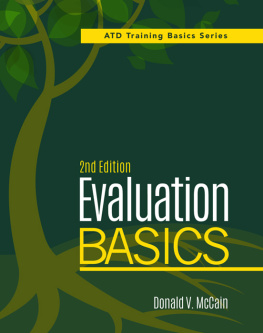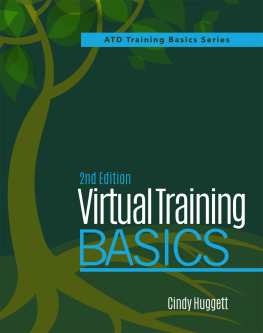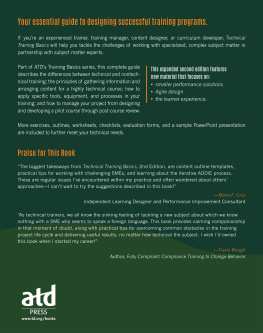Saul Carliner - Training Design Basics
Here you can read online Saul Carliner - Training Design Basics full text of the book (entire story) in english for free. Download pdf and epub, get meaning, cover and reviews about this ebook. year: 2015, publisher: Association for Talent Development, genre: Business. Description of the work, (preface) as well as reviews are available. Best literature library LitArk.com created for fans of good reading and offers a wide selection of genres:
Romance novel
Science fiction
Adventure
Detective
Science
History
Home and family
Prose
Art
Politics
Computer
Non-fiction
Religion
Business
Children
Humor
Choose a favorite category and find really read worthwhile books. Enjoy immersion in the world of imagination, feel the emotions of the characters or learn something new for yourself, make an fascinating discovery.
- Book:Training Design Basics
- Author:
- Publisher:Association for Talent Development
- Genre:
- Year:2015
- Rating:5 / 5
- Favourites:Add to favourites
- Your mark:
- 100
- 1
- 2
- 3
- 4
- 5
Training Design Basics: summary, description and annotation
We offer to read an annotation, description, summary or preface (depends on what the author of the book "Training Design Basics" wrote himself). If you haven't found the necessary information about the book — write in the comments, we will try to find it.
Training Design Basics — read online for free the complete book (whole text) full work
Below is the text of the book, divided by pages. System saving the place of the last page read, allows you to conveniently read the book "Training Design Basics" online for free, without having to search again every time where you left off. Put a bookmark, and you can go to the page where you finished reading at any time.
Font size:
Interval:
Bookmark:


2015 ASTD DBA the Association for Talent Development (ATD)
All rights reserved. Printed in the United States of America.
18 17 16 15 1 2 3 4 5
No part of this publication may be reproduced, distributed, or transmitted in any form or by any means, including photocopying, recording, or other electronic or mechanical methods, without the prior written permission of the publisher, except in the case of brief quotations embodied in critical reviews and certain other noncommercial uses permitted by copyright law. For permission requests, please go to www.copyright.com, or contact Copyright Clearance Center (CCC), 222 Rosewood Drive, Danvers, MA 01923 (telephone: 978.750.8400; fax: 978.646.8600).
ATD Press is an internationally renowned source of insightful and practical information on talent development, training, and professional development.
ATD Press
1640 King Street
Alexandria, VA 22314 USA
Ordering information: Books published by ATD Press can be purchased by visiting ATDs website at www.td.org/books or by calling 800.628.2783 or 703.683.8100.
Library of Congress Control Number: 2015947321
ISBN-10: 1-56286-925-6
ISBN-13: 978-1-56286-925-0
e-ISBN: 978-1-60728-500-7
ATD Press Editorial Staff
Director: Kristine Luecker
Manager: Christian Green
Community of Practice Manager, Learning & Development: Amanda Smith
Developmental Editor: Jack Harlow
Cover Design: Fatimah Weller
Text Design: Maggie Hyde and Tony Julien
Printed by Data Reproductions Corporation, Auburn Hills, MI

ATDs Training Basics series recognizes and, in some ways, celebrates the fast-paced, ever-changing reality of organizations today. Jobs, roles, and expectations change quickly. One day you might be a network administrator or a process line manager, and the next day you might be asked to train 50 employees in basic computer skills or to instruct line workers in quality processes.
Where do you turn for help? The ATD Training Basics series is designed to be your one-stop solution. The series takes a minimalist approach to your learning curve dilemma and presents only the information you need to be successful. Each book in the series guides you through key aspects of training: giving presentations, making the transition to the role of trainer, designing and delivering training, and evaluating training. The books in the series also include some advanced skills, such as performance and basic business proficiencies.
The ATD Training Basics series is the perfect tool for training and performance professionals looking for easy-to-understand materials that will prepare nontrainers to take on a training role. In addition, this series is the consummate reference tool for any trainers bookshelf and a quick way to hone your existing skills.

Training Design Basics explains how to design and develop training programs, primarily those programs intended for the face-to-face or virtual classroom. It also provides guidance for designing and developing self-study training programs, such as online tutorials and workbooks.
Many training design books focus almost exclusively on the analysis and evaluation phases of creating training programs. This one gives as much attention to the design, development, and implementation phases, exploring issues such as how to structure a program (including the parts of every program that would not appear in an outline), choose an instructional strategy, determine which materials you need to develop (such as student and instructor guides for classroom courses), follow clear writing and visual design guidelines for these materials, and conduct a review to ensure that the draft program is likely to achieve its objectives.
This book also focuses on designing and developing these programs in the real world, in which trainers make do with limited time, funds, and other resources. Yes, trainers have to analyze needs and write objectives. After all, trainers need to know what they are training and what the resulting program should accomplish. But trainers often have limited time to get this information and some of the key sources of information are not always available. So this book suggests ways to adjust the effort of gathering and assessing information about a project, a process called analysis, to the realities in which trainers work.
Similarly, although tutorials and other forms of instruction receive much attention in the training press, the majority of training still takes place in the classroom. Therefore, this book focuses primarily on designing and developing classroom programs, while also addressing the design and development of technology-delivered programs.
Finally, after designing and developing training programs, many trainers are responsible for launching and running their programs. This book explores these tasks, too, especially as they relate to administering, marketing, and supporting training programs.
Training Design Basics guides people who have never designed a training program through their first project. It is intended for new course developers and instructors; subject matter experts (SMEs) thrust into training roles; and other nontrainers who find themselves responsible for designing and developing training programs.
The Basics of Designing Training Programs introduces issues to consider when designing training programs, such as the general concepts of learning (and its distinction from information sharing), human performance improvement, and adult learning
The Basics of Planning a Training Project provides an overview of the process for designing training programs and suggests ways to answer the question how much time is needed to design and develop a training program? before you start developing it. This chapter also describes the roles that people play in a training project and suggests ways to effectively work with sponsors.
The Basic Information Needed to Start a Project describes the first part of the analysis phase of instructional design: gathering information. This chapter identifies the information needed to design a training project and why you need that information, and offers suggestions on how to get that information when you have a tight schedule.
The Basic Instructional Objective describes the second part of the analysis phase of instructional design: defining requirements. This chapter explains how to concretely state the goals of a training program and how to assess whether learners have achieved those goals (a step you perform before beginning to design programs).
The Basics of Organizing Training Programs explains the general structure of a program, and how to divide content into units. This chapter delves into the most popular formats (live, self-study) and communication media (classroom, computer) for training programs.
The Basics of Choosing an Instructional Strategy explores a variety of ways to present instructional material so that it engages learners and they retain it.
Next pageFont size:
Interval:
Bookmark:
Similar books «Training Design Basics»
Look at similar books to Training Design Basics. We have selected literature similar in name and meaning in the hope of providing readers with more options to find new, interesting, not yet read works.
Discussion, reviews of the book Training Design Basics and just readers' own opinions. Leave your comments, write what you think about the work, its meaning or the main characters. Specify what exactly you liked and what you didn't like, and why you think so.













